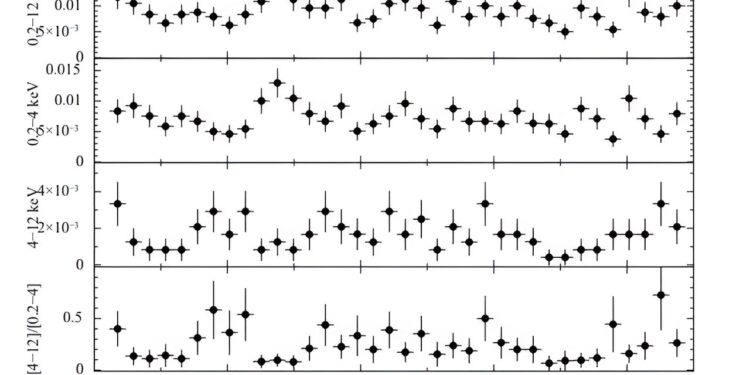EPIC-pn light curve of XMM-Newton of J1431 in the ranges 0.2-12 keV, 0.2-4 keV, 4-12 keV and hardness ratio between hard and soft bands, displayed with a bin size of 2400 s. Credit: De Martino et al., 2024.
Using ESA’s XMM-Newton satellite, European astronomers have made X-ray observations of a binary millisecond pulsar known as PSR J1431-4715. Results of the observation campaign, published on 3 September on the preprint server arXivprovide more information on the nature of this system.
Pulsars are rotating, highly magnetized neutron stars that emit a beam of electromagnetic radiation. The fastest rotating pulsars, with rotation periods of less than 30 milliseconds, are called millisecond pulsars (MSPs). Researchers assume that they form in binary systems when the initially more massive component transforms into a neutron star that then rotates due to the accretion of material from the secondary star.
A class of extreme binary pulsars with semi-degenerate companion stars are nicknamed “spider pulsars”. These objects are further classified as “black widows” if the companion star has an extremely low mass (less than 0.1 solar masses), while they are called “redbacks” if the secondary star is heavier.
PSR J1431−4715, or J1431 for short, is a binary MSP pulsar probably located between 5,250 and 8,400 light-years from Earth. With a rotation period of 2.01 milliseconds and a deceleration power of 68 decillion erg/s, it is one of the fastest and most energetic pulsars.
Previous observations have shown that the pulsed radio emission of J1431 is affected by strong eclipses at the binary orbital period of about 10.8 hours. The system was also found to host a non-degenerate donor star with a minimum mass of 0.12 solar masses, and therefore J1431 was classified as a red-backed star.
However, since J1431 was discovered in 2015, it remains a poorly studied MSP. That is why a team of astronomers led by Domitilla de Martino of the Capodimonte Astronomical Observatory in Naples, Italy, decided to study J1431 in X-rays using XMM-Newton. Their study was complemented by multiband optical photometric data from the European Southern Observatory’s 3.5-m New Technology Telescope (NTT) in Chile.
Observations revealed that the X-ray spectrum of J1431 is featureless and consistent with non-thermal emission with a power photon index of 1.6 and negligible absorption. In addition, the presence of a thermal component was detected, which could indicate the contribution of the heated polar cap in the soft X-rays.
The collected data indicate that the companion star is an early F-type star with a mass of about 0.2 solar masses, confirming the red-backed nature of J1431. However, the companion star was found to be hotter than most red-backed stars, as its dayside and nightside temperatures were measured at about 7,500 and 7,400 K, respectively.
From the observations, astronomers found that J1431 has a binary inclination of 59 degrees and that the system is about 10,100 light-years away, farther than previously estimated. The data also suggests that the pulsar is massive, with its mass estimated to be between 1.8 and 2.2 solar masses.
More information:
D. de Martino et al, Optical and X-ray observations of the millisecond pulsar binary PSRJ1431-4715, arXiv (2024). DOI: 10.48550/arxiv.2409.02075
Journal information:
arXiv
© 2024 Science X Network
Quote:New observations shed more light on the nature of a millisecond pulsar binary (2024, September 9) retrieved on September 9, 2024 from
This document is subject to copyright. Apart from any fair dealing for the purpose of private study or research, no part may be reproduced without written permission. The content is provided for informational purposes only.



